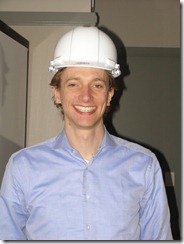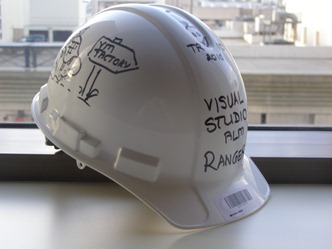The Rangers Virtualisation Session #2, an event mixed with imagination, excitement and avid chalk&talking
Feedback from our session on VM Factory today …
Today we … Bijan, Paul and I … presented the session Rangers Visual Studio 2010 Virtualization Guidance and VM Factory, which went reasonably well in the short period of time we had. To fill some of the gaps and mention some of the interesting discussions, I have decided to type up this post before finding some food :) Firstly a big thank you to Bijan for arranging the hardhats and driving the session quality, for Paul on flying all the way from the Netherlands to share his excitement and expertise on the topic, and to the audience who collaborated actively and made us think during and especially after the session.
Paul Meyer, from the Netherlands, … our factory master.

Context
As Bijan emphasised the world of virtualisation is exploding. Moore’s law (https://en.wikipedia.org/wiki/Moore%27s_law), the need to consolidate hardware, the availability of multi-core and cheap random-access-memory (RAM) are some of the driving factors. Combine these with the huge possibilities and promises that virtualization brings to the table and you are suddenly excited about the future. BUT, to make virtualization a success it has to be easy to build functional and consistent virtual images, efficiently and consistently. While a manual effort can achieve all of these objectives, as outlined in out “Virtualization Guidance for Visual Studio 2010” guidance document, the VM Rangers factory delivers an automated and low maintenance solution as part of the Rangers Virtualization Guidance and the VM Rangers factory.
We have been dogfooding our VM guidance and VM factory, and we are both convinced and excited about the virtualization journey that we have embarked on a year ago.
The four puzzle pieces
In the session we spoke about four main puzzle pieces, which I think we should reiterate again:
- Planning … we have a quick reference capacity planning poster, shared with the Visual Studio 2010 Quick Reference Guidance. This poster can be used to plan the hardware for both a physical environment and a virtualized environment, using the second puzzle, which covers this poster in more detail. What is important is that whether you are considering a physical or virtual environment, plan, plan and plan again …. time spent on the whiteboard will be well rewarded and as with software solution designs, a change on the whiteboard is easier and cheaper than one to a solution running in production.
![image_14[1] image_14[1]](https://msdntnarchive.blob.core.windows.net/media/TNBlogsFS/BlogFileStorage/blogs_msdn/willy-peter_schaub/WindowsLiveWriter/tECHREADYdAY1tHERANGERSVIRTUALISATIONSES_103D4/image_14%5B1%5D_thumb.png) … this poster, currently hosted on Codeplex, will be updated shortly … in fact we have revised the poster to match latest load and performance tests and are waiting for the thumbs up signal as I type.
… this poster, currently hosted on Codeplex, will be updated shortly … in fact we have revised the poster to match latest load and performance tests and are waiting for the thumbs up signal as I type. - Guidance … the guidance consists of three main documents.
- The first guidance document “Virtualization Visual Studio ALM Rangers Base Image Guide” documents the manual process needed to create the VM Rangers base image step-by-step and covers the automation scripts used to optimise and configure the operating system as per guidance.
- The second guidance document “Virtualization Guidance for Visual Studio 2010” documents the first puzzle, the poster, in a lot more detail, looks at suggested scenarios and introduces hyper-v and other virtualization technology based guidance.
- The third guidance document “Virtualization Guidance for Visual Studio ALM Rangers Factory” is focused on building and using the VM Rangers factory.
- Factory … this is the main puzzle piece, which is a VM to create (TFS/VS) VM’s, with the ability to control the creation process.
- Starter Factory … the starter factory is a VHD that contains the pre-installed factory, with trial based media and task sequences (the magic dust). It allows you to create your own factory in minutes … and if you have another factory that you can connect to, you can run a script included in the starter pack that synchronizes your factory with another factory, ensuring that yours is up to date and has all of the necessary magic dust.
The discussions
- What are the possible scenarios?
- This question probably threw us in terms of our timing and could turn this post into a never-ending thesis, because the possibilities are endless. Your imagination is the limit of the factory.
- Can/should we consider the factory for development environments?
- Absolutely. It is one scenario the guidance does elude to, because if we consider a software development company that has 10 development teams, with developers moving from team to team. Would it not be great if we could build a base image for all developers? Would it not be even better if we could build a project specific image? With the latter, the technical lead can give all new team members an image and they can be up and running on a pre-configured development and test environments within minutes.
- Can we consider the factory for training environments?
- Do you need to rebuild training machines with a consistent environment? If yes, create magic dust that defines your environments and let the factory do the network crawling, clicking and installations for you.
- Will the factory support lab management?
- We can create images to be consumed by lab management, but a closer integration has been on the whiteboard, but is not within scope at this stage. Give us your thoughts on this … what is missing, what should we focus on? An environment we have not, but should explore, is the test and lab management environment … again your feedback will be appreciated.
- Will the guidance and factory include other virtualization technologies, i.e. VMWare?
- We have recently pinged the Visual Studio ALM MVP community working with the Rangers and based on their feedback and today’s discussion, we will probably have to embrace other virtualization technologies with future guidance and factory configurations.
- What administrative model is recommended?
- Centralised. get an administrator or small team to support, enhance and maintain the factory. Point the consumers at a share containing the started ISOs and let them use the factory, mostly without their knowledge. It just works for them. The administrative efforts with the family are mainly around creating customised task sequences for new image configurations and testing them … a task best left to one or few factory administrators.
- Where can I run the factory?
- Anywhere … your laptop, your workstation your server … you can even create a factory at a customer site and help them automate their image creation environment. Again the limit = your imagination.
Where can I find more information?
 The one place to go is https://msdn.microsoft.com/en-us/teamsystem/ee358786.aspx (https://www.tinyurl.com/almrangers), where you will find information on the Visual Studio ALM Rangers and a link under “Related Resources”, that takes you to the Visual Studio ALM Rangers Solution Page, which in turn points you at the relevant Codeplex sites. Alternatively look under the News heading on the right, where you will find the relevant links to the most recent Visual Studio ALM Rangers Codeplex sites.
The one place to go is https://msdn.microsoft.com/en-us/teamsystem/ee358786.aspx (https://www.tinyurl.com/almrangers), where you will find information on the Visual Studio ALM Rangers and a link under “Related Resources”, that takes you to the Visual Studio ALM Rangers Solution Page, which in turn points you at the relevant Codeplex sites. Alternatively look under the News heading on the right, where you will find the relevant links to the most recent Visual Studio ALM Rangers Codeplex sites.
So, we now head for another four days of sessions and 6 more exciting Rangers sessions.
 … the Rangers factory hard hat. Thanks Bijan!
… the Rangers factory hard hat. Thanks Bijan!